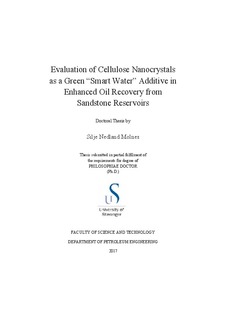| dc.contributor.advisor | Strand, Skule | |
| dc.contributor.author | Molnes, Silje Nedland | |
| dc.date.accessioned | 2017-08-10T10:27:02Z | |
| dc.date.available | 2017-08-10T10:27:02Z | |
| dc.date.issued | 2017-06-15 | |
| dc.identifier.citation | Evaluation of Cellulose Nanocrystals as a Green "Smart Water" Additive in Enhanced Oil Recovery from Sandstone Reservoirs by Silje Nedland Molnes, Stavanger : University of Stavanger, 2017 (PhD thesis UiS, no. 348) | nb_NO |
| dc.identifier.isbn | 978-82-7644-715-6 | |
| dc.identifier.issn | 1890-1387 | |
| dc.identifier.uri | http://hdl.handle.net/11250/2450399 | |
| dc.description | PhD thesis in Petroleum engineering | nb_NO |
| dc.description.abstract | Petroleum reservoir production is frequently supported by using flooding fluids, and offshore this fluid will very often be seawater. The efficiency of this water injection is affected by various factors, such as the wettability of the reservoir rock and the mobility ratio between reservoir oil and injected fluid phase. These factors again influence sweep efficiency, which is the fraction of the total reservoir oil volume in contact with injected fluid during oil recovery. Addition of nanoparticles can affect the sweep efficiency on both a macroscopic and microscopic level by increasing the volume of petroleum in contact with the flooding fluid, and divert the flow of water to lesser flooded parts of the reservoir.
In this thesis work, cellulose nanocrystals (CNC) have been investigated as a potential green additive alternative for enhanced oil recovery (EOR), in combination with the Smart Water low
saline brine technology. Presented in this thesis are studies investigating the effects of different physical and chemical environments that low concentration CNC dispersions may be subjected to at oil reservoir conditions. First, various concentrations of CNC dispersed in de-ionized water and in a 1000 ppm NaCl brine were subjected to variations in salinity, pH and temperature, and the results confirmed that the dispersions remained stable within the salinities known to affect the wettability of sandstone, as well as the pH range expected in sandstone oil reservoirs. Stable dispersions were also observed when heated to temperatures ranging from 50 to 90 °C. At extended heat aging at 90 °C and 120 °C for seven days, beginning degradation was observed for both types of CNC dispersions, with viscosity increase and pH decrease as the most important indicators. CNC dispersed in 1000 ppm NaCl brine was generally more heat tolerant than the CNC dispersed in de-ionized water. A fluid that increases its viscosity with heat and time will be easier to inject due to a low initial viscosity, and when the viscosity increases in the porous reservoir, this effect could lead to increased sweep efficiency and better oil recovery.
The injectivity of CNC into a high-permeable sandstone core has been investigated by performing flooding experiments on 100 % water saturatedcores, using increasing concentrations of CNC and increasing temperature.
These investigations confirmed that most of the viscosity generating CNC particles travelled through the cores at all the tested temperatures and CNC concentrations. Oil recovery experiments showed that when CNC-LS brine was used in tertiary mode, an increase in ultimate recovery was observed. During tertiary CNC-LS injection, the CNC particles increased fluctuations in differential pressure, which could be linked to log jamming in pore throats and remobilisation of oil in the pore space. These results indicate that CNC particles may have potential as a green flooding fluid additive, but that further investigations are needed. | nb_NO |
| dc.language.iso | eng | nb_NO |
| dc.publisher | University of Stavanger, Norway | nb_NO |
| dc.relation.ispartofseries | PhD thesis UiS;348 | |
| dc.relation.haspart | Silje Nedland Molnes, Ivan D. Pifierez Torrijos, Kristofer G. Paso, Skule Strand, Kristin Syverud. “Sandstone injectivity and salt stability of cellulose nanocrystals (CNC) dispersions – Premises for use of CNC in enhanced oil recovery”, Industrial Crops and Products, 2016. Vol. 93, 152 – 160. | nb_NO |
| dc.relation.haspart | Silje Nedland Molnes, Kristofer G. Paso, Skule Strand, Kristin Syverud. “The effects of pH, time and temperature on the stability and viscosity of cellulose nanocrystal (CNC) dispersions – Implications for use in enhanced oil recovery”, Submitted to Cellulose, 03.02.2017. | nb_NO |
| dc.relation.haspart | Silje Nedland Molnes, Aleksandr Mamonov, Kristofer G. Paso, Skule Strand, Kristin Syverud. “Investigation of a new application for cellulose nanocrystals – A study of the enhanced oil recovery potential from sandstone by use of a green additive”, Submitted to Cellulose, 21.03.2017. | nb_NO |
| dc.rights | Copyright the author, all right reserved | |
| dc.rights | Navngivelse 4.0 Internasjonal | * |
| dc.rights.uri | http://creativecommons.org/licenses/by/4.0/deed.no | * |
| dc.subject | petroleumsteknologi | nb_NO |
| dc.subject | cellulose nanocrystals | nb_NO |
| dc.subject | enhanced oil recovery | nb_NO |
| dc.subject | eor | nb_NO |
| dc.subject | sandstone reservoirs | nb_NO |
| dc.subject | petroleum reservoir production | nb_NO |
| dc.subject | CNC | nb_NO |
| dc.title | Evaluation of Cellulose Nanocrystals as a Green "Smart Water" Additive in Enhanced Oil Recovery from Sandstone Reservoirs | nb_NO |
| dc.type | Doctoral thesis | nb_NO |
| dc.description.version | publishedVersion | nb_NO |
| dc.rights.holder | Forfatteren | nb_NO |
| dc.subject.nsi | VDP::Technology: 500::Rock and petroleum disciplines: 510::Petroleum engineering: 512 | nb_NO |

